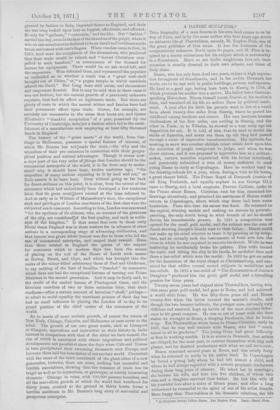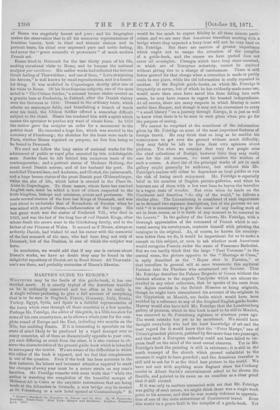A DANISH SCULPTOR.* Tills biography of a man famous in
his own land comes to us by way of Paris, and is by the same author who four years ago wrote an elaborate life of Thorwaldsen, namely, M. Eugane Plon, son of the great publisher of that name. it has the freshness of the comparatively unknown North upon its pages, and M. Plon is in spired by a hearty enthusiasm for his subject which is noteworthy in a Frenchman. Much as our Gallic neighbours love art, their attentiou is usually directed to their own schools aud those of Italy alone.
Bissen, who has only been dead two years, enjoys a high reputa- tion throughout all Scandinavia, and in his native Denmark his works are to be met with iu public buildings, palaces, and squares.. He lived to a good ago, having been born iu Slesvig in 1798, of which province his mother was a native. His father was a German- speaking Holsteiner. Bimini himself learnt Danish at his mother's. knee, and remained all his life an ardent Dane by political senti- ment. A year after his birth his parents went to live at a small farm about twenty-five miles from Slesvig, where he passed his. childhood among brothers and sisters. His two brothers became clockmakors of the first order, one settling in Slesvig, and the other in Paris; as to Vilhelm, he showed at a very early age his. disposition for art. It is told of him that he used to model his. sticks of liquorice, and never eat them up till they had passed through a series of expressive transformations. His aptitude for working in snow was another childish talent which drew upon him. the attention of people competent to judge, and when he was- about sixteen, and it was proposed to apprentice him to a cabinet- maker, certain notables acquainted with his father interfered,. and generously subscribed a sum of money suniuient to send young Bissen to study at Copenhagen. Here he worked hard in the drawing-schools for a year, when, during a visit to his home,. a great chance befell. The Prince Royal of Denmark (cousin of old King Frederick, and equally nephew to oar George III.) came to Slesvig, and a local magnate, Provost Callisen, spoke to the Prince about Bissen. Christian sent for him, examined his. drawings attentively, and promised his assistance if Bissen would return to Copenhagen, about which step there had been some hesitation. From this time his career was fixed. He returned to- the capital, winning medals and making an income by portrait- painting, the only doubt being to what branch of art he should devote his incontestable powers. In 1821 a competition wasp opened for the small gold medal, and the subject was the sons of Jacob showing Joseph's bloody coat to their father. Nelsen could not make up his mind whether to treat it by painting or by sculp- ture, and he actually took the instruments of both arts into the room in which be was required to execute his sketch. While he was hesitating he accidentally broke his palette. This trifle turned the scale, and taking the clay in his bands, he modelled then and there a bas-relief which won the medal. In 1822 he got an order for the decoration of the royal chapel at Christiausborg, and exe- cuted for that edifice several sacred subjects in medallions and bas-reliefs. In 1823 a bas-relief of " The Resurrection of Jaime's- Daughter " produced him the great gold medal and a travelling: pension for three years.
Twenty-seven years had elapsed since Thorwaldsen, having won that same great gold medal, had gone to Rome, and had achieved a world-wide fame. He was fifty-three years old and Bissell twenty-five when the latter entered the master's studio, and though the two became intimate, the younger man, naturally very diffident and reserved, kept up habits of the most absolute defer- ence to his great compeer. He was so out of heart with the first. statue he wrought at Rome, a sleeping Bacchante, that he broke it up. Yet Thorwaldsen wrote home to Prince Christian, early in 1827, that he was well content with Bissen, who had " much talent in all he produces." The young Dane had great difficulty at first in working marble. It is so scarce in Denmark, that artiste are obliged, for the most part, to content themselves with clay and plaster, and for fiuiehed productions with what we call terre-cuite.
Bissell remained several years in Rome, and was nearly forty when he returned to settle in his native land, In Copenhagen, he found a young lady whom he had left almost a child, and whom he had always regarded with a certain prophetic tenderness during these long years of absence. lie asked her in marriage ; she became his wife, and bore him five children, of whom two sone and a daughter survived their father. lie lost this wife of his youthful love after a union of fifteen years ; and after a long widowhood lie remarried to the sister of one of his artist friends. More happy than Thorwaldsen in his domestic relations, the life
* Lo Soepteui. Lanoi4 Mem Innen. Par Eugbne Plon. Paris: Henri Pim of I3issen was singularly honest and pure ; and his biographer makes the observation that in all his numerous representations of feminine beauty, both in ideal and historic statues and in portrait busts, his chisel ever expressed pure and noble feeling, and never the " grace sensuelle of provocante " of much modern French art.
Bissen lived in Denmark for the last thirty years of his life, making occasional visits to Rome, and he became the national sculptor par excellence. His earlier works had reflected the intense Greek feeling of Thor walasen ; and one of them, " Love sharpening his Arrows," is well known by small reproductions, and is a beauti- ful thing. It was modelled in Copenhagen shortly after one of his visits to Rome. Of his Scandinavian subjects, one of the most noted is " The Citizen Soldier," a colossal bronze statue erected on a granite base at Fredericia, in Jutland, after the Danish victory over the Germans in 1849. Dressed in the ordinary tunic, which admits no statuesque folds, and brandishing a branch of beech over his head, the Citizen Soldier offered a somewhat difficult subject to the chisel. Bissen has rendered him with a spirit which causes the spectator to pardon any want of classic form. In 1850 the nation gave the sculptor an order for a monument to the patriot dead. He executed a huge lion, which was erected in the cemetery of Flensbourg ; the sketches for the beast were made in Paris, whither Bissen repaired on purpose, no live lion being to be found in Denmark.
We need not follow the long series of national works for the adornment of public or royal piles executed by this indefatigable man. Besides these he left behind him numerous busts of his contemporaries ; and a portrait statue of Madame Heiberg, the much loved Danish actress, and of her husband the poet. He modelled Thorwaldsen, and Andersen, and CErsted, the jurisconsult, and a huge bronze statue of the great Danish poet CEhlenschlesger, twice the size of life, which latter is erected in the Place St. Anne in Copenhagen. To these names, whose fame has reached English ears, Must be added a host of others respected in the little kingdom, bishops and ministers, artists and professors. He made several statues of the four last Kings of Denmark, and was just about to undertake that of Bernadette of Sweden when he was seized with mortal illness,—inflammation of the lungs. His last great work was the statue of Frederick VII., who died in 1863, and was thelast of the long line of reed Danish Kings, after whose death the crown went to the Ghicksburg family, and to the father of our Princess of Wales. It seemed as if Bissen, always so ardently Danish, had 'wished to end his career with the memorial of the last monarch of his race, who had been king not only of Denmark, but of the Duchies, in one of which the sculptor was born.
In conclusion, we would add that if any one is curious about Bissen's works, we have no doubt they may be found in the delightful repository of Danish art in Bond Street. All Thorwald- een's are there, and probably statuettes of Bissen's likewise.



































 Previous page
Previous page